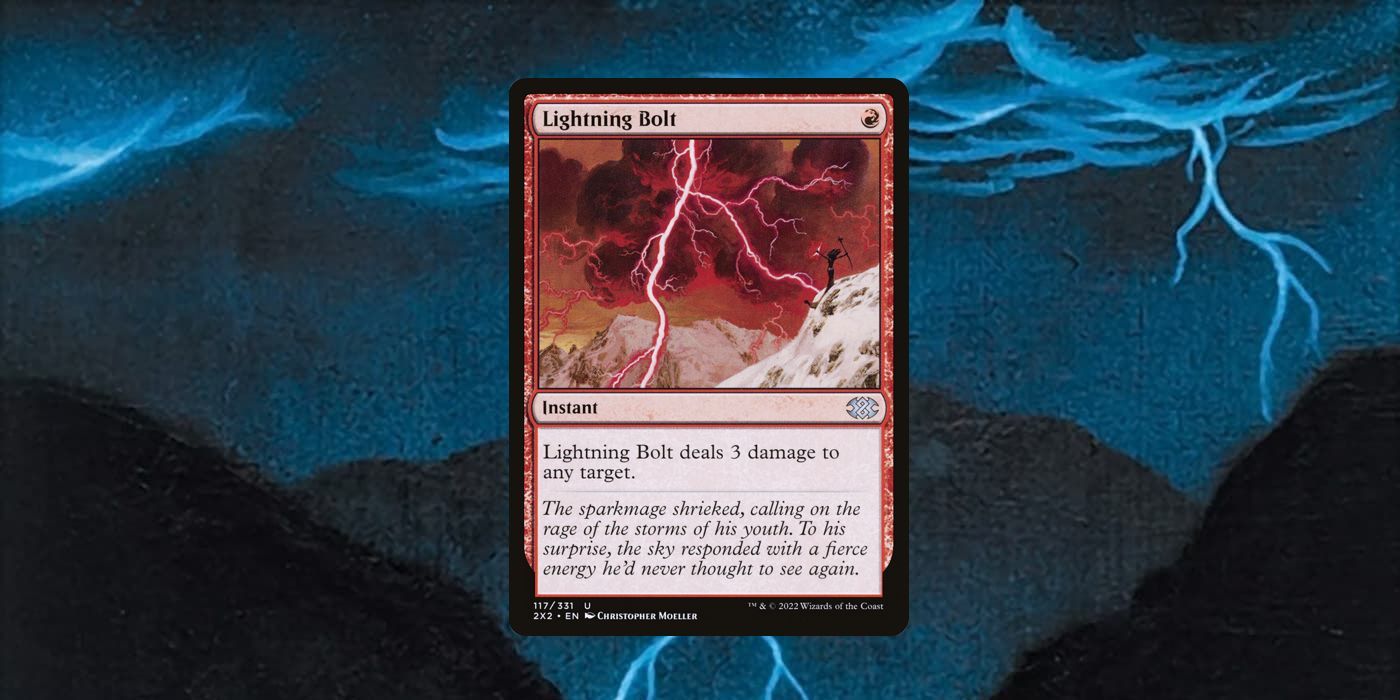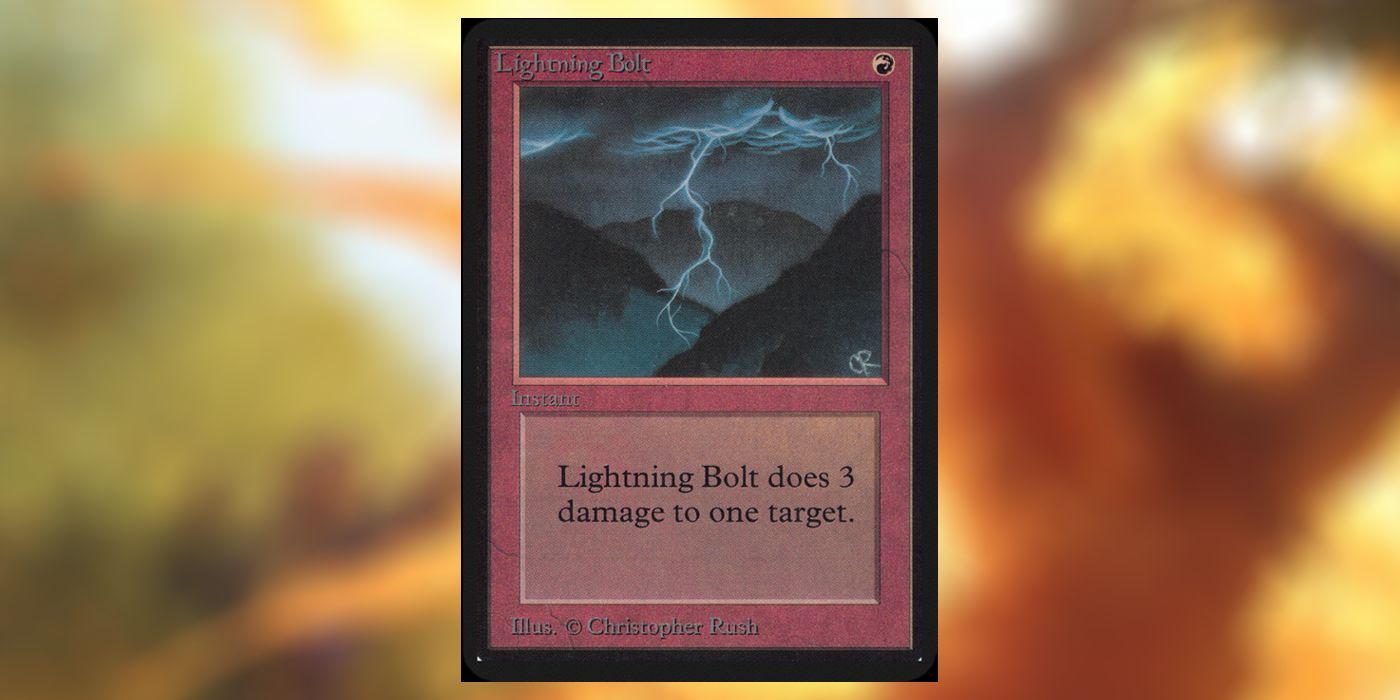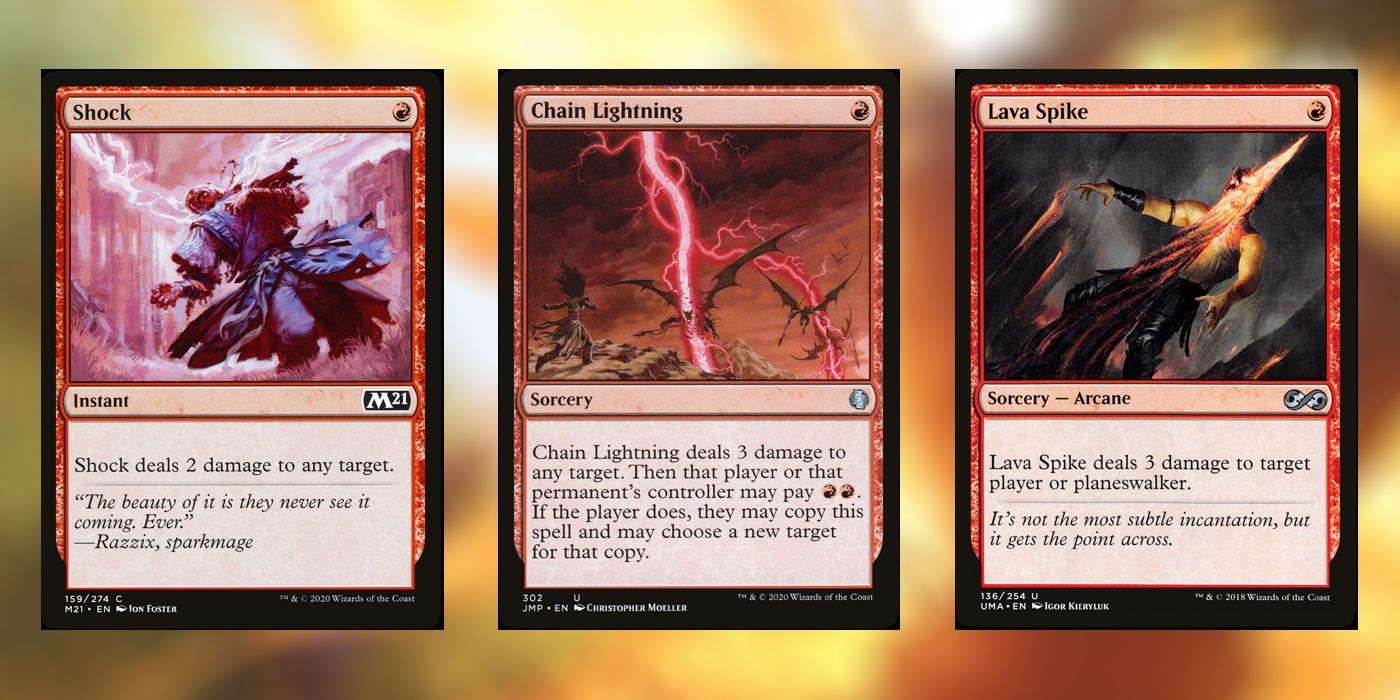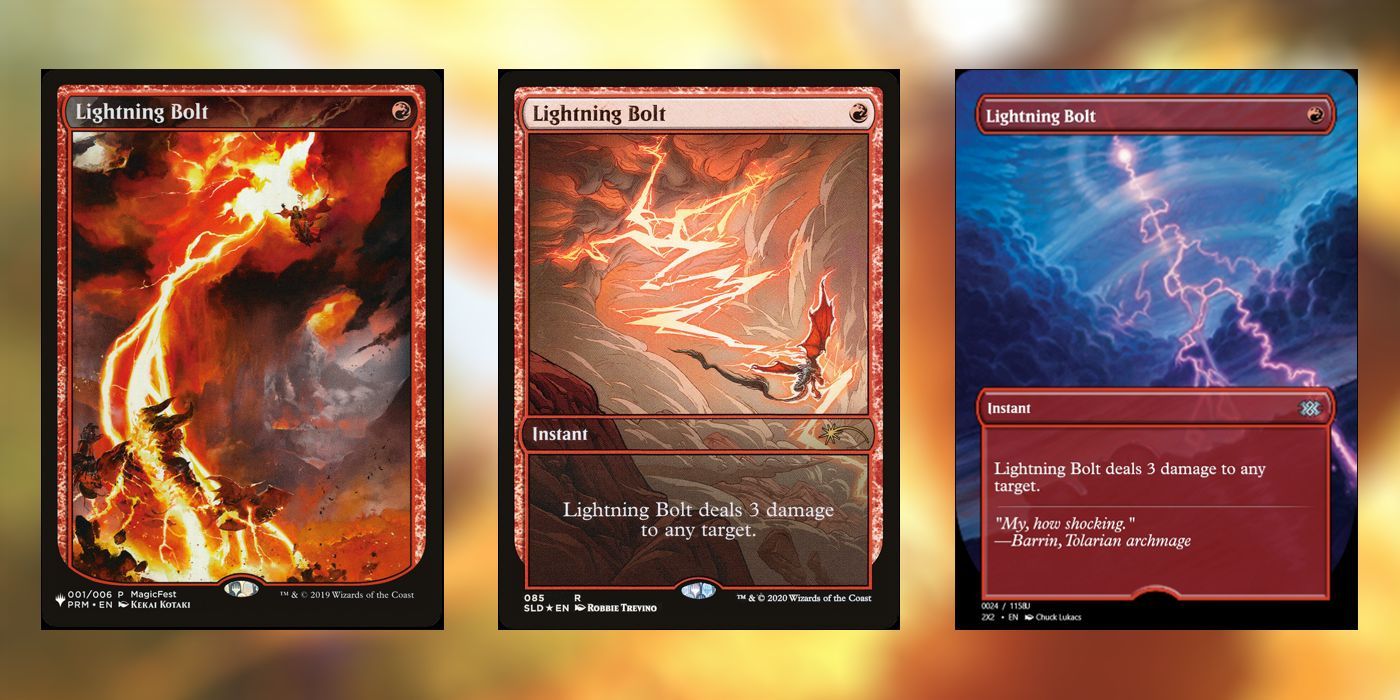Summary
- Lightning Bolt is a highly recognizable and iconic card in Magic: The Gathering, known for its simplicity and powerful damage-dealing abilities.
- Lightning Bolt's versatility and efficiency make it an MTG staple in formats like Legacy and Modern, where it can be used to control opponents or finish off games.
- Lightning Bolt's instant speed, high damage output, and flexibility in targeting players or creatures make it the standard for burn spells and a top choice for many players.
There are a few cards in Magic: The Gathering's history which nearly any player can recognize on sight. There are fewer cards that even a new player could fully understand at a glance. There are even fewer cards that combine ease of use, iconic status, and a perfect match of flavor and function. In a game where new cards are constantly played and printed crystallized in amber through dozens of reprints, Lightning Bolt is still the best Burn spell ever printed. The few formats in which it sees play showcase why Bolt will never see printing in standard, because of its ruthless efficiency married to Swiss Army knife-like versatility. Bolt has etched itself into the history of Magic with the speed and impact of its namesake. Despite this, it may be overlooked compared to the more complex or flashy cards, especially by newer players.
Some cards are just the best, but what makes this humble one mana instant stand with titans like Force of Will? What has made this card, which was designed in Magic's original playtest and has seen virtually no change since, so good that it has yet to be topped by any other burn spell? Why is this card still the standard for any damage-dealing spell. The short answer is that Lightning Bolt became that standard. For the long answer, it's necessary to go on a deep dive into its history and its design to fully understand and appreciate this card.
Lightning Bolt in Magic's Past and Present
Lightning Bolt is a one-mana red instant that deals three damage to any target. Often shortened to Bolt, the card serves as a premiere burn spell and removal spell, given that it can deal its damage to either a player, a creature or even a planeswalker. Bolt has been a foundational pillar for Magic: The Gathering ever since it was printed in the Alpha set of MTG. That was not even the first time it was printed as Bolt was printed in the original Gamma playtest by Richard Garfield. In Alpha, however, it would come to be part of the Boon Cycle, which were a series of cards that focused on the number 3, demonstrating the main driving philosophy behind each of Magic's 5 colors. Lightning Bolt, being a one Mana instant that deals 3 damage to any target, demonstrated red's aggressive damage-dealing nature.
Bolt caused problems early in Magic's History when there was no limit on the copies of nonland cards a player could play in a deck. Players realized that one could make a deck consisting of 40 Bolts and 20 Lands and defeat opponents very quickly. Even when Magic instituted a 4 card rule Bolt has been a fearful thought lingering in the back of any player at 3 life. The card has swung many games by being the last spell resolved, often serving as the flashy finishing move of a Magic game. At the same time, it can often be cast as the first spell from a player in some games. One specific mantra, "Bolt the Bird", refers to destroying Birds of Paradise with Lightning Bolt. Killing the Birds of Paradise was a good way of disrupting an opponent's turn-one play, thereby displaying that Bolt could be used to control as well as pressure the opponent's life totals.
Lightning Bolt currently sees play in Legacy and Modern, seeing play in the Burn decks of the latter while seeing play in Delver decks that play red. Even outside any specific deck built around it, Bolt will sometimes show up in a deck as a way of either dealing with smaller creatures or of closing out a game. Bolt hasn't really ever dominated any format, but it's always been viable in any 60 card constructed format it's legal in. The only format that it generally suffers in is Commander, in which 3 damage is far less pivotal and the fact that Commander decks can only have a single copy of any card prevents the card from benefiting from multiple copies.
Lightning Bolt Breakdown
Bolt is an unassuming card by the standards of 2023 Magic, so much so newcomers may even underestimate its power. The first key to its power is that it's the most damage per mana of any one mana instant in the game. Other comparable spells either only deal 2 damage for 1 mana, like Shock or Lightning Burst, or they aren't as flexible compared to Lightning Bolt. Lightning Bolt is what is known as "strictly better" than any other one mana burn spell. Strictly better refers to when a card is nearly objectively better than another card for the same cost. Lightning Bolt is strictly better than Shock, given that it deals 3 damage instead of 2 for the same cost. To make burn spells after Bolt, Wizards have had to make inferior versions.
One other key card of comparison is something like Chain Lightning. It also deals 3 damage for 1 mana, so what makes it worse than Bolt? The answer to this question is wrapped in the second key to Bolt's power: instant speed. Without even getting into the downside, which is sometimes relevant and sometimes not, Chain Lightning is a sorcery. Bolt is an instant, which means it can be played at the most opportune moment for the Bolt player and it can even be played on an opponent's turn. Bolt can be played in response to lifegain, which means it can potentially kill a player before their life is saved as the bolt will resolve first.
The third key to Bolt's power is its flexibility. The card can be played on creatures or players. Lava Spike is often compared to Bolt and is played in many burn decks, but Spike doesn't see play in the control or tempo decks that Bolt does. That's because Bolt in those decks can hit an opponent and kill them or alternately remove a key creature. Three damage will kill most early-game threats and even some mid-game ones, often coming with a mana advantage as the Bolt player used a one-mana spell on a creature that often costs two, three, four or even more mana.
What Makes Lightning Bolt Iconic
Lightning Bolt is a good card, a great card even, but it's also an Iconic card. Bolt has become a foundation of Magic's jargon, with the term being used to refer to not just Lightning Bolt but also other similar direct damage spells. Bolt has led to many a Magic saying like "Bolt the Bird" or "out of Bolt range." In lists of Iconic cards, Lightning Bolt often hits the top for Magic as a whole, which is very hard in a game so stratified in experiences between casual and competitive and then between different formats.
Part of Bolt's incredible appeal comes through in its impeccable simple yet evocative flavor. A bolt of lightning is so easy to understand and casting bolts of lightning at opponents puts Magic players in the shoes of the Wizards they are supposed to be emulating very well. While immersion is usually a word afforded to video games or TTRPGs, Lightning Bolt is a masterclass in getting Magic players to buy into the fiction that they are powerful mages battling across planes with incredible spells.
Magic is a complex game, woven together through interlocking systems that can sometimes be difficult to navigate. There is something powerful in simplicity, but it's hard for simplicity to endure. Vanilla creatures are often the first to suffer from power creep and are almost always forgotten. There are hundreds of draw spells, burn spells, and lifegain spells that are printed and then fall into the abyss of Magic's history. Even the Boon Cycle, Lightning Bolt's cycle, suffers from this with cards like Healing Salve being largely irrelevant to everyone, Giant's Growth being outpaced with time and Dark Ritual and Ancestral Recall both being too good for the game in many ways. Lightning Bolt has outstripped all of them in fame and use, because of that elegant simplicity. It's also often the measuring stick for what makes a good burn spell. The other spells fall short of Bolt often because Bolt simply is the gold standard for what a burn spell could ever be. Four damage for one mana would be ludicrous at instant speed, effectively burning an opponent for nearly half their life with only two spells and removing even some of the toughest creatures.
There's an irony to a card meant to capture a single, devastatingly fast stroke of lightning being as enduring as stone. That a card meant to depict something so ephemeral has become part of the bedrock of the game. The turn of phrase "lightning in a bottle" comes to mind and is apt to describe how the card has preserved some of the magic of 1993 and by extension some of the initial childlike wonder that players feel when they first thumb through an MTG pack. In a world so different than the one Lightning Bolt helped create, it's nice to see that its design has not only stood the test of time but continued to thrive despite that often cruel creep of power with every new set.




